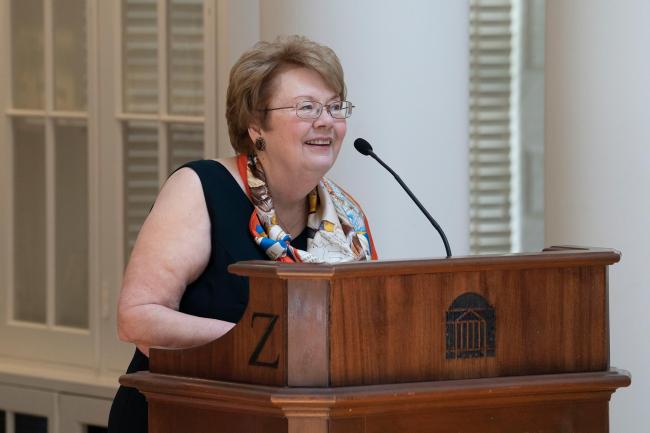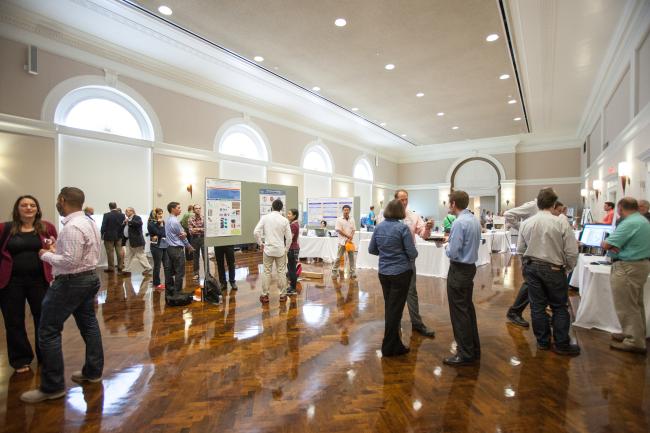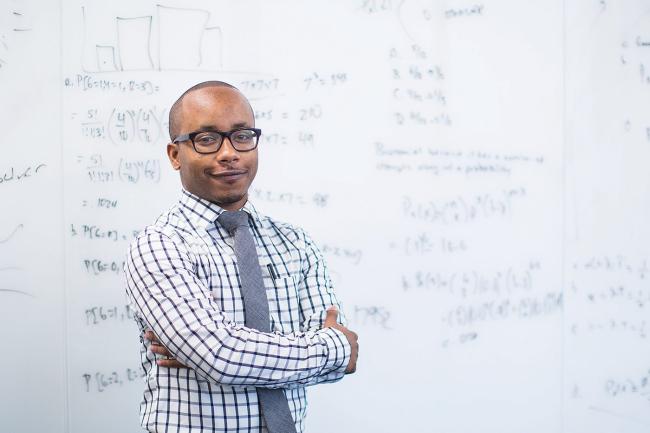Arlyn Burgess
Arlyn Burgess started at the Data Science Institute in 2014, the first staff hire by the institute. She has held a variety of roles there and now at the School of Data Science in the years since. She is now associate dean for administration and has played a key role in the construction of the new building for the School of Data Science.

Based just on her undergraduate transcript, Arlyn Burgess may not seem the obvious first staff member hired by the Data Science Institute in early 2014. An oboe performance and religious studies major, Burgess was a 2009 graduate of Northwestern University.
She came to Charlottesville shortly thereafter to join her now husband who was in a doctoral program at UVA. She inquired with a local oboe teacher about jobs and discovered one at the University’s Department of Music in administration. It would prove to be eye-opening.
“Very quickly I realized that, since I was just out of college, there was a whole side of higher ed that I never understood as a student,” she said.
Burgess would eventually move from a student-facing role to one where she oversaw the graduate program and learned about the finances involved. Her interest in the field led her to obtain a master’s degree in education, focusing on higher education, particularly the quantitative aspects of administration and planning.
Meanwhile, by 2014 it had become increasingly clear to Don Brown that the nascent Data Science Institute needed help.
“I was realizing that we were really starting to hemorrhage in terms of the amount of things we were trying to do,” he said. “It was just getting incredible.”
While Burgess did not have a background in data science, she conveyed her passion for the field during her interview, a quality that proved to be exactly what Brown was looking for.
“Wow, this is what we need,” he remembered thinking after meeting with Burgess. “We need people who are enthusiastic about this because this can be a lot of work.”
Burgess would become the first staff member hired by the Data Science Institute. She vividly recalled her first day.
“I met Don there, and he opened up the door, and he said, ‘Here’s your office,’” Burgess recalled. “And it was a completely empty room, tiled floor — there were lights, but there was no furniture.”
So, Brown gave her a very sensible first assignment: buy some furniture. “I knew from that point on that it was going to be a build it as we go,” Burgess said of the institute, which, for years, would operate out of spartan office spaces, including a red shed at the Dell 1 building on Grounds.
After getting settled in, Burgess would soon embark on an outreach mission, building relationships across the University that could help propel the new institute forward.
“I spent very little time in my office,” Burgess said. Instead, she worked in places like the dean’s office at the Engineering School or the library, while, at the same time, getting to know key people in the Departments of Computer Science and Statistics.
“I basically built a team of people who were interested in working on data science,” she said. Above all, her job was “data science evangelist,” connecting the people and points of interest of data science to move the institute forward.
Her efforts, along with those of Brown and Jeff Holt, would reap benefits that summer as the Data Science Institute admitted its first cohort of master’s students.
The Data Science Institute was breaking new ground in many ways, one of which was that, in addition to its research mission, it would also have the ability to confer degrees — a first for an institute at UVA.
“None of the other institutes that UVA formulated, these cross-school institutes, had a teaching component,” said Don Brown.
President Teresa Sullivan, who was keeping close tabs on the labor market and talking with employers, was also strongly supportive of the idea that the institute should produce data science graduates.
Employers “want to know that you’ve got expertise in data science — they don’t want to sit there and parse through your transcript and try and figure out if you do,” she said. By conferring data science degrees, they wouldn’t have to.
Brown’s objective was to establish a residential master’s degree in data science within the first year. It was an ambitious goal with plenty of challenges.
For starters, there was resistance from the UVA Faculty Senate, particularly from the Statistics Department.
“They were not happy about it, a data science program living outside of statistics,” Brown said. However, they didn’t have nearly enough voting power to quash the idea. So, the master’s proposal went to the State Council of Higher Education for Virginia for final approval, which granted it enthusiastically.
The next mission was bringing in students, a tricky task that first year given that the program hadn’t yet been approved, which meant the institute couldn’t recruit applicants.
“I used to joke that they clearly were data scientists, because in order to discover our program, they had to be,” said Brown of that first class.
One way or another, word spread about the new program, and the applications followed. Ultimately, 175 people applied to join the inaugural 2014-15 master’s in data science cohort and nearly 50 would matriculate, a far higher number than Brown expected.
“They were extraordinarily excited because, of course, they were reading like everyone else that data science was really the field of the future,” he said.
That excitement proved helpful to Brown and his small staff as they worked to build a program from scratch.
“They just loved everything we did even when we didn’t know what we were doing,” Brown joked.
“It was unbelievable to see the different backgrounds that they came from and their enthusiasm to be the guinea pigs,” Arlyn Burgess said.
Despite growing pains and resource challenges, the first class would graduate on time in 2015. When they did, Provost John Simon leaned over to Brown and, underscoring the historic nature of a UVA institute conferring degrees for the first time, said, “Did you feel the earth shift?”
President Sullivan read the degree conferral with text she wrote herself: “I confer upon you the degree of master of science, with all the rights and privileges thereunto belonging and charge you to use your knowledge and skills to continue exploring, analyzing, and safeguarding data to make discoveries to advance the world, while treating data ethically and with regard to the privacy rights of individuals.”
By the program’s second year, the number of applicants to the data science master’s program had nearly doubled to 340.
Don Brown and others continued working to fine-tune the master’s program to make it more effective for students. “We created, basically, a foundation for what would become the curriculum in both the undergraduate and Ph.D. programs through what we were doing in the master’s program,” Brown said.
Part of the reason the curriculum needed to be continually reexamined and refined over the years was to ensure that it kept up with changes in data science.
“The field just continues to evolve with new breakthroughs in various ways,” said Brown. “And that’s what makes it so exciting.”
Meanwhile, plans began for an event to showcase the data science work that was now well underway at UVA.
“We knew that there were a lot of people doing data work,” said Arlyn Burgess. “We knew that there were a lot of people interested in working with other people that were doing data work. And honestly, we wanted people to see us as an ally.”
Burgess spoke with a friend in the office of the vice president for research, and an idea began to formulate around bringing people together from the UVA community who were doing data-driven research to let them talk about their work.
Burgess and the team reached out to associate deans for research at UVA schools, asking for candidates to discuss data-focused work. While the first Datapalooza, held on Sept. 18, 2015, was organized and funded by the Data Science Institute, it was truly a University-wide event, with representatives from all 11 UVA schools participating.
The institute “was the platform to showcase the data-driven research that was happening all over Grounds,” said Burgess.
Datapalooza would include panel discussions and a resource fair, as well as keynote remarks from Johan Bos-Beijer of the General Services Administration and Linda Abraham, the co-founder of comScore who would go on to serve on the board of the School of Data Science.
The event has “evolved over the years,” said Burgess.
“But that very first one was, how do we bring these people together?” she added. “How do we create a platform to elevate that conversation and get those people in conversation with one another?”
Datapalooza has been held every year since, and the conference continues to foster collaboration across UVA and promote data science. The name has also stuck, which Brown credited to Burgess.
“We still have Datapalooza, and that name still sounds right,” he said.
Job openings in data science continued to grow, but the professional landscape wasn’t always as well defined. When Reggie Leonard joined the Data Science Institute in 2015, it was more like the “wild West,” he said.
Job listings were at times confusing, and, in many cases, companies that weren’t actually doing data science were seeking data science applicants.
“It was really hard to help students figure out what jobs to apply to,” Leonard recalled.
Leonard knew something about professional uncertainty. He was a psychology major in college and remembers hearing from people who assumed he must be planning to go to graduate school since, they told him, there weren’t any jobs in his field.
“I realized how little reflection, and little space for reflection, I even had for making that decision for what was next,” Leonard said.
He would go on to graduate school, receiving a professional counseling degree at Liberty University, and found a new direction and purpose: career development.
After staying on at Liberty as a career counselor, Leonard learned about an opportunity that spoke to another interest of his: technology and innovation.
“Data science was on my radar, not necessarily as data science but more so as big data,” he said. He would join the Data Science Institute as assistant director of career services in June 2015, just after the first cohort of data science master’s students received their degree the month before.
Using LinkedIn, he reached out to as many new alumni as he could to make connections. “Have you landed something?” he said he would ask. “Let me see your résumé. Do you know how to interview for a data science opportunity?”
During that initial period, Leonard maintained his focus on building contacts with alumni and determined how he could best support them as they sought to launch their careers.
As time went on, Leonard’s career advice, like the degree program itself, would evolve to reflect the changing nature of the field.
“Two to three years into my time at Data Science, all business analysts and data analyst roles started to have R and Python” skill requirements, he said, referring to the programming languages. “The level of technical rigor for data scientists was increasing,” Leonard added.
In addition to Leonard’s work to build a career services component within the institute, an emphasis was also placed on ensuring master’s students were gaining the practical experience they would need through capstone projects.
In these projects, which continue to be required for graduation, students generally work with an academic, commercial, nonprofit, or governmental organization to develop a data science project designed to address a sponsor’s actual need. It’s a way for students to learn from, and hopefully overcome, the challenges that arise from tackling real, and often very difficult, data science questions.
“It’s a learning experience of how real data science works,” said Don Brown.
Arlyn Burgess recalled hearing from students who had been scheduled to present their capstone work to the institute’s advisory board during one of their initial meetings in 2015. The students were concerned they wouldn’t have anything compelling to show to board members because of the problems they had encountered.
“That sounds to me like your presentation,” Burgess said she told the group. It was an illustration of what Brown and Burgess referred to jokingly as the 80-20 rule: 80% of the time data scientists are cleaning and wrangling their data while the other 20% of the time they’re complaining about it.
Brown thought the experience was constructive for the board.
“I think the board members, when they met with students, that really helped them to understand that this was the way it was in the world and to expect that kind of thing,” he said.
Teaching students how to effectively present their research has long been an emphasis of Brown’s.
“We just constantly hammer talk about motivation,” Brown said.
“Why are you doing this? Why is this important to somebody?” he says he tells students as they are thinking about how to discuss their data science research with non-technical audiences, including during job interviews.



